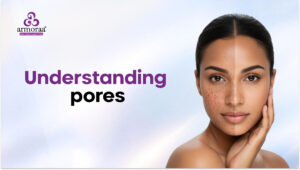UNDERSTANDING PORES
Pores are normal tiny openings on the surface of skin, which serve as pathways for sweat and oil to release.
Sweat pores:
They are connected to sweat glands beneath skin, to release sweat and regulate body temperature. They are extremely small and not visible.
Oil or sebaceous pores:
These are openings of the pilosebaceous follicles in skin, that is connected to hair follicles and oil (sebaceous) glands. Through these pores, sebum (skin’s natural oil) is released to moisturize and protect the skin. ENLARGED PORES are of aesthetic concern, hence will be the topic of discussion in this blog.
Pores are distributed all over the body, but highest and most visible in areas rich in sebaceous glands – face (particularly nose), chest, shoulders and upper back.
They are hardly visible in the young and tend to get more noticeable as one gets older.
CAUSES OF PORE ENLARGEMENT:
- Genetics: Pore size is predominantly determined by genetics.
- Skin type: Oily skin tend to have larger facial pores, particularly concentrated around and in the T-zone.
- Hormonal influence:Fluctuating hormones during adolescence, menstruation, pregnancy stimulate sebum production. Excessive sebum secretion can stretch pores beyond their capacity. The oil, dirt and dead cells further clog up pores enlarging their appearance.
- Aging:As we age, there is a decline in collagen and elastin. This results in lack of support around the pores, making them stretched along with skin sagging.
- Sun Exposure: UV damage breaks down collagen fibres around pores and darkens them, making them more noticeable.
- Skin Conditions: Acne, rosacea, chicken pox, with inflammation and subsequent scarring contribute to damaged, dilated, distorted pores.
- Environmental Pollution: Dirt, pollutants and micro particles clog pores and stretches them out.
- Dehydration:Pores appear more prominent against dry, dehydrated skin.
- Comedogenic Products: Oils, thick creams, makeup and pore-clogging ingredients occlude pores, stretching them out.

Steps to Prevent Enlargement of Pores:
- Gentle Cleansing: Use a mild exfoliating face wash twice daily. Avoid physical scrubs and aggressive rubbing of skin.
- Moisturize well: Oily skin type also require moisturizer to hydrate (light weight gel based), at least twice a day.
- Protect from Sun Damage: Use a broad-spectrum sunscreen with minimum SPF 30 daily. Wear wide-brimmed hats, thick dark clothing and limit direct sun exposure.
- Exfoliate Regularly: The type of chemical exfoliant (lactic acid/ glycolic acid/ salicylic acid/ mandelic acid/ polyhydroxy acids) and the frequency of usage are best left to your dermatologist to choose and decide based on your skin type (dry/ combination/ oily/ sensitive).
- Non comedogenic products: Utmost care should be taken especially if you have oily acne prone skin. Choose gel-based and light weight products.
- Diet: Restrict high dairy, oily fried food and sugar consumption. This increases hormones, which in turn stimulates sebum production and acne. Drink at least 2.5 -3 litres of water per day for hydrated, supple skin.
Treat Acne Early:
✅ Comedones, popular, pustular, nodular and cystic acne can lead to scarring, change in skin texture and enlarged pores.
✅ Avoid picking and squeezing any type of acne, which further stretches pores and risks infection and scarring.
✅ See a dermatologist for early intervention with appropriate skin care, oral medications, chemical peels and extractions if required.
AT HOME SKIN CARE: A dermatologist will be your best guide to prescribe a skin routine based on your skin’s unique needs. Hydrating and soothing agents like hyaluronic acid and centella, Niacinamide AHAs, BHAs, prescription based topical medications such as retinoid may be prescribed to remove dead cells from clogging pores, regulate sebum production, boost collagen, and even out pigmentation.
PROFESSIONAL IN CLINIC TREATMENTS TO MINIMIZE OPEN PORES:
These clinical procedures may be recommended after skin analysis by a dermatologist, based on the severity of the pores. Each treatment has its own approach and mechanism of action.
- Facilitate breakdown of sebum and pore decongestion:
- HydraFacial
- Chemical peels
- Intense pulse light Laser (IPL)
- Stimulation of collagen and skin tightening, resulting in shrinkage of enlarged pores:
- Radiofrequency (RF) Skin tightening, micro needling (MN), MNRF.
- LASERS: CO2, ERBIUM, Pico, Q switch, Long pulsed Nd: YAG, IPL.
- Deep peels
POINTS TO NOTE:
- No treatment can change the number of pore openings or shrink actual pore size. Treatments aim to exfoliate and tighten loose pore walls via collagen stimulation. This a slow and gradual process that requires patience and consistency.
- Maintenance treatments are required over time as aging, sun exposure and collagen loss are a continual process.
- Preventive habits such as daily skin routine, proper diet and lifestyle are crucial for maintaining long-term results.
Conclusion
Pores are essential to skin’s health. A variety of factors beyond one’s control like genetics, hormones and sun damage contribute to pore enlargement over time. A balanced and customized skin routine along with professional treatments can be therapeutic as well as preventive. Setting realistic expectations is essential with pore treatments – while they cannot be eliminated, it is certainly possible to minimize their appearance and keep them clear and healthy.




